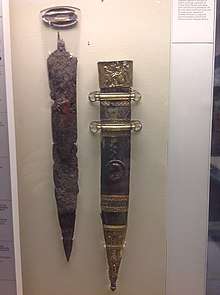Mainz Gladius
The Mainz Gladius or Sword of Tiberius is a famous ancient Roman sword and sheath that was found in the Rhine near Mainz in Germany. Since 1866 it has been part of the British Museum's collection, when it was given to the museum by the philanthropist Felix Slade.[1]
| Mainz Gladius | |
|---|---|
 The Mainz Gladius on display at the British Museum, London | |
| Material | Iron and gilded bronze |
| Size | 58 cm long |
| Created | 15 AD |
| Present location | British Museum, London |
| Registration | 1866,0806.1 |
Description
The sword is made of iron (now heavily corroded) and the sheath of tinned and gilded bronze. The length of the sword is approximately 58 cm long by 8 cm wide. The decoration on the scabbard illustrates the ceding of military victory to Augustus by Tiberius after a successful Alpine campaign. Augustus is semi-nude, and sits in the pose of Jupiter, flanked by the Roman gods of Victory and Mars Ultor ('the Avenger'), while Tiberius, in military dress, presents Augustus with a statuette of Victory.
Ownership of the sword
This prestigious weapon was likely to have been commissioned by a senior officer in the Roman army to celebrate a victory in the lengthy and bloody military campaigns in Germany. Victory in these campaigns was essential for the expansion and protection of the Roman Empire's border, and the symbolic act of presenting these victories to the emperor avoided the destructive rivalry between generals which had previously brought down the Roman Republic.
Replica
A replica of the Mainz Gladius can be found in the Romano-Germanic Central Museum (Mainz).
References
Further reading
- Burn Lucilla, The British Museum Book of Greek and Romans Art